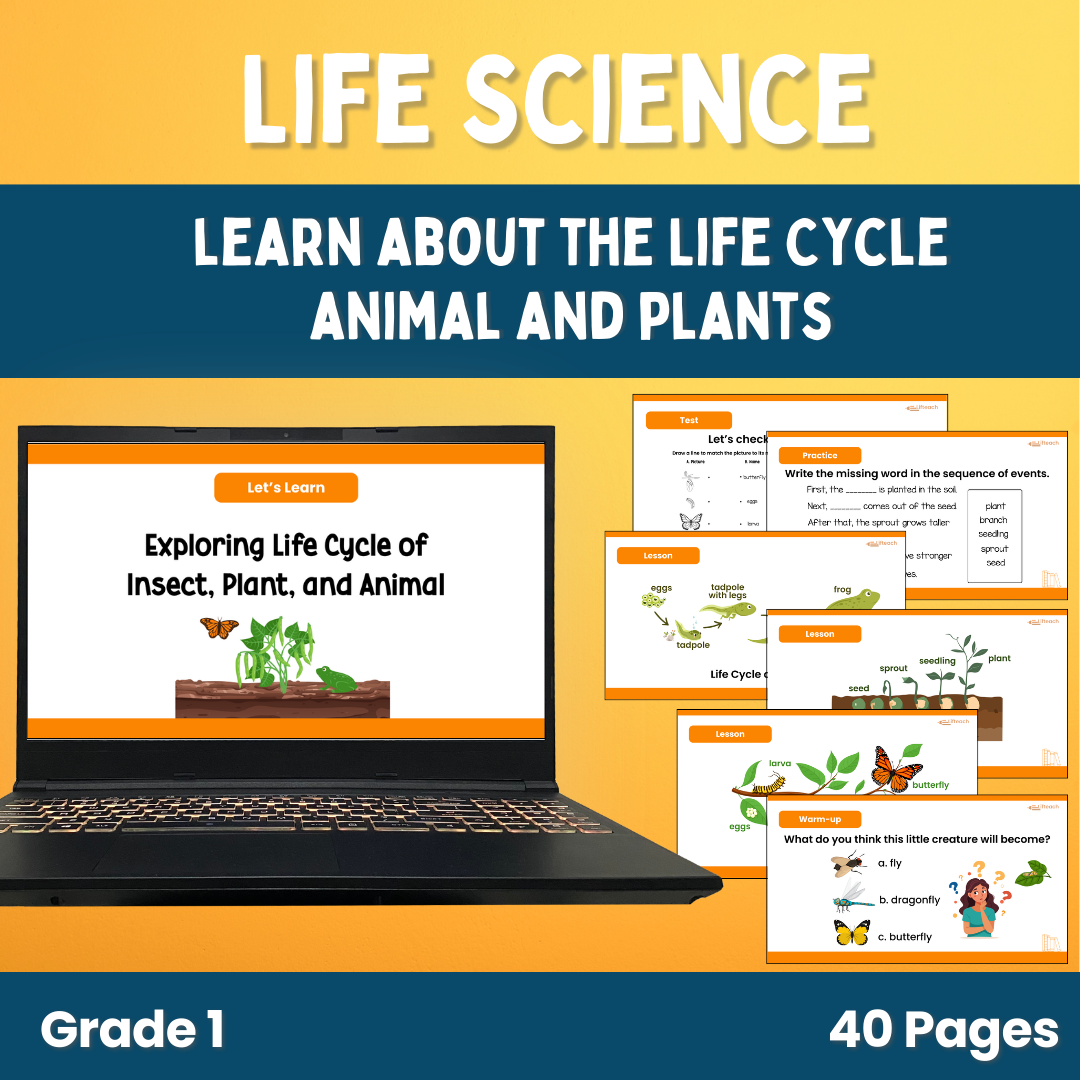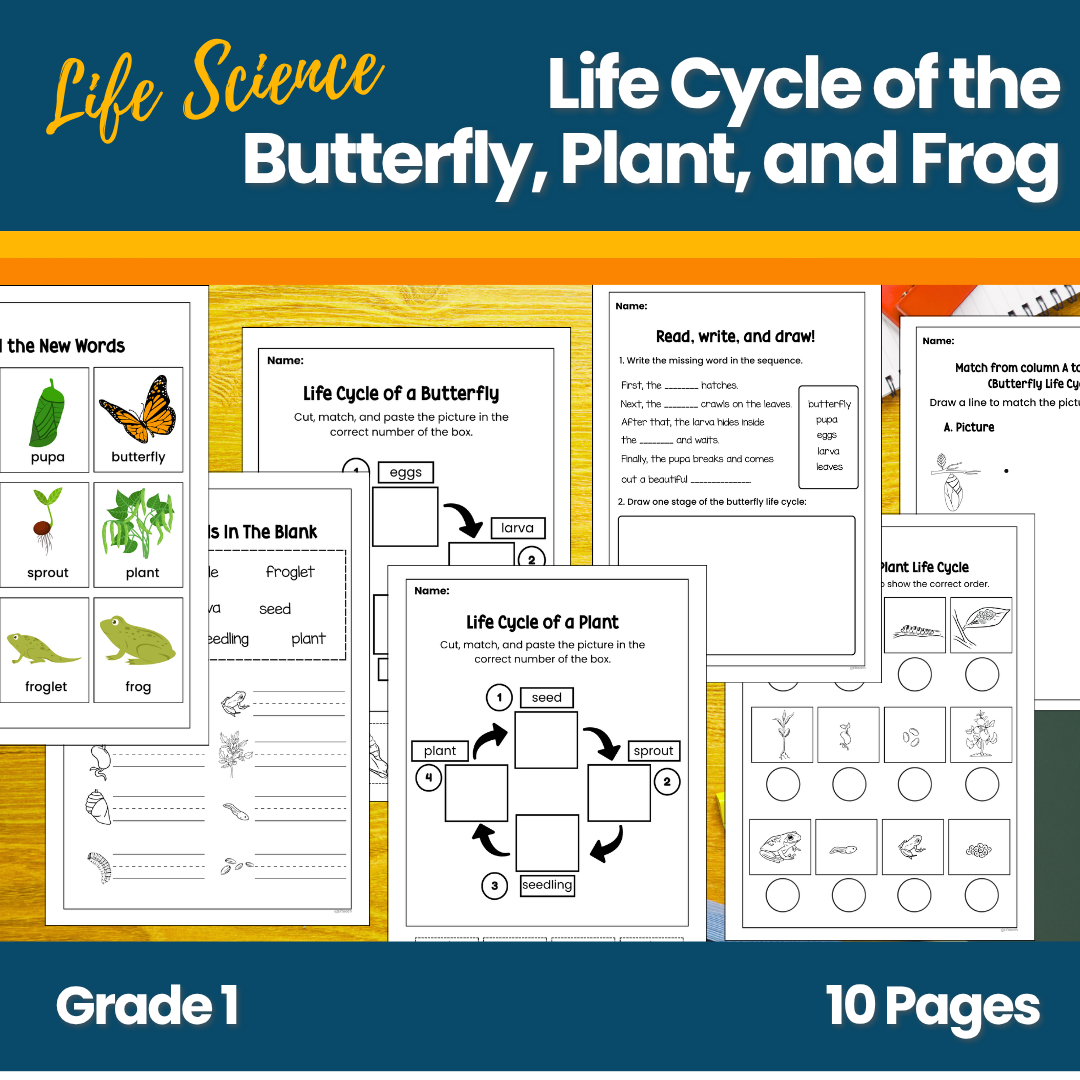Lesson Plan: Life Cycle of a Butterfly, Plant, and Frog
Grade Level: Grade 1
Subject: Life Science
Duration: 50 minutes
1. Standards Alignment
Science (NGSS)
- 1-LS1-2: Read texts and use media to determine patterns in behavior of parents and offspring that help offspring survive.
English Language Arts (CCSS)
- CCSS.ELA-LITERACY.RI.1.2: Identify the main topic and retell key details of a text.
- CCSS.ELA-LITERACY.SL.1.1: Participate in collaborative conversations about grade-appropriate topics.
2. Learning Objectives
By the end of this lesson, students will be able to:
- Observe and describe the stages in the life cycle of a plant and an animal (e.g., seed → plant; larva → butterfly; egg → tadpole → frog).
- Predict what happens next at each stage of the life cycle.
- Use key vocabulary to explain life-cycle stages.
- Participate in group discussions to compare plant and animal life cycles.
3. Materials & Resources
- Chart paper & markers
- Life-cycle picture cards (seed, sprout, flower, fruit; egg, larva, pupa, butterfly)
- Short video clip: “Caterpillar Shoes by The Old Branch” (7 minutes)
- Student journals or blank paper
- Scissors, glue sticks, crayons
- Exit-ticket quiz (5 questions)
- Worksheet: Cut-and-paste life-cycle diagram
4. Vocabulary
- larva – a wingless and wormlike feeding form that hatches from the egg of a butterfly
- pupa – is a process between the larva and the adult, where the insect is undergoing transformation
- butterfly – a colorful, flying insect with large, patterned wings
- seed – a small, often hard, part of a plant that contains a baby plant, called an embryo, and stored food, all protected by a seed coat
- sprout – a tiny new plant that grows from a seed
- plant – a living thing that grows from the ground, usually has roots, stems, and leaves, and can make its own food using sunlight, water, and air
- tadpole – the larval stage of a frog or toad, characterized by a round body, long tail, and gills for breathing underwater
- froglet – a young frog that has recently transformed from a tadpole
- frog – a type of tailless amphibian known for its smooth, moist skin, long, powerful hind legs, and ability to jump and swim
5. Timeline & Activities
| Time | Component | Description |
| 0–5 mins | Warm-up Hook | Ask, “What do you think this little creature will become?” Show the student the short clip of Caterpillar Shoes. |
| 5–10 mins | Introduce Vocabulary | Present a chart of key words & simple definitions. Students repeat the words. |
| 10–20 mins | Lesson Proper: Discussion | Have the students read the words as the cycle progresses in the life of a butterfly, a plant, and a frog. |
| 20–30 mins | Guided Practice: Sorting Game | Ask students to cut, paste, and match the item from the worksheet. |
| Ask students to read and write the missing word on the blank. They will learn sequencing words (first, then, next, and at last). | ||
| 30–40 mins | Independent Practice: Drawing | Students will draw their favorite animal or plant life cycle. |
| 40–48 mins | Assessment: Exit-Ticket Quiz | A short 4-5 question quiz of matching type and sequencing. |
| 48-50 mins | Review & Reflection | Gather in a circle, and call on volunteers to share one thing they learned. Ask, “Which stage is your favorite and why?” |
6. Instructional Strategies
- Think-Pair-Share: Engages all learners.
- Multimodal Input: Video + picture cards + discussion.
- Hands-on Sorting & Craft: Kinesthetic reinforcement.
- Sentence Frames: “First the egg hatches. Next…” helps ELLs and struggling writers.
7. Assessment Methods
- Formative: Observations during the sorting game; teacher questions in discussion.
- Summative: Exit-ticket quiz; labeled drawing in journal.
- Worksheet: Completed cut-and-paste diagram accuracy.
8. Differentiation Strategies
- For Struggling Learners: • Provide pre-cut picture cards. • Offer sentence starter strips.
- For Advanced Learners: • Challenge to write two sentences comparing plant vs. animal life cycles. • Research an additional life cycle (e.g., frog) and share with class.
- ELL Supports: • Visual vocabulary cards with pictures. • Pair with a buddy.
9. Reflection
After class, reflect on:
- Which activity most engaged students?
- Did students accurately sequence life-cycle stages?
- How effective were the sentence frames and visuals?
- Plan adjustments for learners who struggled.
10. Worksheets
- Life-Cycle Diagram Cut-and-Paste
- Labeling & Sequencing: Blank life-cycle circles for students to number 1–4 and label.


